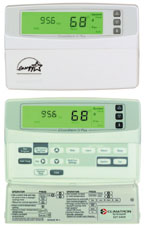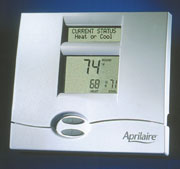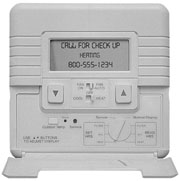The trend among control and hvac accessory manufacturers definitely seems to swing toward the more complex, programmable, zoneable thermostat systems. However, new products have also come out for smaller applications and less technically skilled owners — the middle of the roaders.
Note: This article also includes introductions of more sophisticated thermostat-zoning products, as well as a couple of products that are less complicated. The middle can cover a lot of ground.
Also, descriptions such as “more or less sophisticated” are relative; a lot depends on the skills and technical knowledge of the end user. Just remember: Studies have shown that if the end user doesn’t understand how to use the thermostat or other home controls, that customer is less likely to get all the benefits they could. Match the product to the customer’s technical level; the less training that’s required, the better.

MID-RANGE COMPLEXITY
PSG Controls, Inc.(Perkasie, PA), cheered, “We finally got the programming right!” of its Medallion programmable thermostats. “Programmable thermostats save energy, but the programming has been a nightmare for both the contractor and the end user,” the company said.“Most people can program the [Medallion] units without any instructions — they are that simple to program,” the company continued. “Programming that is 5-2 or all 7 days can have the same economy/comfort times and temperature settings.”
Features include auto changeover from heat to cool, a two-speed fan, continuous fan speed, and user-selected fan configuration (depending on the model selected). It also features soft stop and comfort limits.
The face plate is simple: high, low, auto, and stop. Three buttons along the bottom indicate fan, up, and down arrows (for controlling temperature).
The Medallion also features “Service Watch,” which helps contractors remind customers that their equipment needs service and maintenance performed either by the homeowner (filter changes) or the contractor (system checkup). The contractor sets the hours of fan run time; when that time has elapsed, a message on the thermostat tells the homeowner when filters need to be changed.
The hvac systems’ run-time hours are also set by the contractor; when those hours are up, the thermostat displays a message to call the contractor for a system check-up. The telephone number of the service contractor also is displayed (10 digits). The display reads “Call for Check Up,” with system needing service (filter/ heater/air conditioning) and the contractor’s phone number.
The homeowner presses up or down buttons, and the “Check Up” display disappears, returning to the normal temperature display. However, the “Call for Check Up” will then be displayed for 1 minute every 15 minutes, then automatically returns to normal temperature display; this function will continue until the contractor resets the run time.

the programmable thermostat’s promise.”
According to Timothy Butler, senior product manager of Maple Chase, “The programming is completely intuitive, unlike any other thermostat on the market.
It was designed to be so simple, you can program it without a manual.”
The thermostat has a soft-key programming technique common in cell phones and ATMs, the company said. The thermostat walks users through programming step by step. Options include 7-day, 5-2 day, 5-1-1 day, and 24-hr programming.
The model also features a large dot-matrix display with a 20% larger font size; special software that enables the thermostat to be programmed in English, Spanish, or French; and a website (www.aboutinsight.com) where users can access specs, manuals, programming-setup instructions, and sell sheets.
For a zoned product with a moderate level of user complexity, Honeywell (Golden Valley, MN) offers its Chronotherm® IV Plus programmable wireless thermostat for retrofit zoning; it is now much easier for contractors to install with the company’s RF wireless thermostat, the company said. The Chronotherm IV is also sold as a standalone thermostat.
This latest model of Chronotherm can be used with single- or multi-zone receivers for zoned control of up to three areas, the company said. Its pulse-code modulation won’t interfere with other wireless systems, and it can be mounted in each zone of living space up to 200 ft from the receiver.
The thermostat’s bright LCD display and preprogrammed temperature settings offer proven energy savings, the company said. It’s also easy for the user to change the temperature up or down manually.
“This product works like a regular thermostat,” commented Janell J. Siegfried, Siegfried Dunlay Corp., Golden Valley, MN. “The fact that it is wireless is a benefit from an installation standpoint, but doesn’t affect how a consumer interacts with the product.”
The T8665A thermostat provides electronic control of 24 vac heating-cooling systems. It is used in conjunction with the W8665A receiver for 1H/1C single-zone conventional applications. It is used with the W8665E receiver for up to three zones, along with a Honeywell EMM-3 Electronic Minizone® Panel, EMM-3U Universal Electronic MiniZone, or TotalZone™ panel.
Systems, Controls & Instruments, L.L.C. (Pipersville, PA) recently introduced its TED Series 24-vac thermostats for hvac systems, ptac’s, and fancoil units. The thermostats are said to be easy to operate and are low cost. An external temperature sensor is optional.
This basic model offers cool, off, heat, and auto-on fan settings. Models range from one heating zone and one setpoint, to two heating zones, one cooling zone, and one setpoint (for heat pumps).
The company’s ERT 24 Series 24-vac thermostats are said to be fully digital and easy to install. Again, an external return sensor is optional. The faceplate is designed to be easy for the homeowner to navigate.
CTC’s (A Hunter Fan Company, Memphis, TN) mechanical thermostats are available in horizontal and vertical configurations. All models offer the company’s “quiet switching” mercury-bulb design. The company said these models require no subbase for heating, cooling, or heating-cooling installations.
The company’s Model 43004, for example, is a horizontal unit designed for use with most four- or five-wire, 24-vac systems and single-stage heat pumps. Model 43005 is the vertical unit. Model 43320 is a vertical unit that may be used with most two-wire, 24-vac systems. It has a fixed cooling anticipator and no subbase is required.
Heat-only thermostats also are available in this new line.

FOR MORE SOPHISTICATED CUSTOMERS AND APPLICATIONS
Research Products Corp.(Madison, WI) announced the first-quarter release of its new Aprilaire® Communicating thermostat. The new system boasts increased flexibility and easier installation, according to Sean McCarthy, Aprilaire sales manager.The new features include a universal thermostat for multiple hvac applications; a large, backlit temperature display; and an optional customized message display. Current features include central monitoring and remote monitoring capability.
Intuitive Windows-style point-and-click software features individual and global equipment schedules, adjustable energy management limits, and software security lockouts (to eliminate the need for lockboxes). Accessories include remote, flush-mounted temperature sensors and humidity sensors.
Incorporating hvac automation into a building’s heating-cooling system allows for energy control as well as a comfortable environment, McCarthy said. Limits can be set for temperature overrides from a PC. Individual users can then control their own comfort within energy management guidelines.

The thermostat features Master thermostat zone monitoring and override, an economy mode, 5-1-1 setback programming, manual or auto changeover, and system programming for central a/c or heat pump systems.
The Master thermostat can be used to override individual zone thermostats, the company explained. The CMS Master unit can monitor, change, and lockout changes in any or all zones. All equipment selection is done at the Master stat. It features fan control, the 5-1-1 programming, emergency heat, and an unoccupied economy mode setting of up to 10 days.
Each CZT zone stat also features 5-1-1 programming in heat, cool, and auto changeover modes, plus economy heat and constant fan participation.
They are joined by the CCB control board, which operates as a “home base” to centralize the wiring. This unit can handle up to three zones; expansion boards are available.
The board features easily identifiable terminals for all wiring, a fuse for circuit protection, and an indicator light to verify system communication. A fault indicator can be wired to the panel, as can an outdoor temperature sensor that relays information to the Master thermostat.
The entire ComfortMax zone control system joins operation of the company’s Master and Slave thermostats and zone dampers, which are all wired to the circuit board.
Sidebar: What’s Next? Controlling Your T-stat From Your Car
Jim Devlin, president ofInvensys Home Control Systems(Richmond, VA), announced that the company will provide the in-home communication infrastructure for the pilot of OnStar at Home, a system that will allow homeowners to access and control home systems from their vehicle, portable computer, or wireless phone.According to Devlin, the pilot is designed to enable homeowners to remotely manage household activities such as locking and unlocking doors; operating the security system, thermostats, and lights; and viewing the home’s interior via a Web camera. The pilot program, which will be tested in the coming months in approximately 100 Detroit, MI-area households, is an initiative of the Internet Home Alliance, of which Invensys and its four corporate OnStar at Home partners (General Motors, Panasonic, Hewlett-Packard, and ADT Security Services, Inc.) are members.
In the pilot, the Invensys server manages the homeowner’s communications to the home, “ensuring commands received via any OnStar channel reach the correct house in a form that can be understood by an Invensys gateway device. Inside the home, the gateway enables communication between an Invensys thermostat, the lighting, and the home security system, all while communicating over the Internet with the Invensys server.”
According to Devlin, later this year Invensys will offer the Home Manager energy management system (ems), a service he said will give utilities a cost-effective way to implement price-responsive load control and obtain usage data while giving homeowners a tool to control their energy consumption. He said the company views the OnStar at Home pilot program as an opportunity to showcase its ability to provide in-home communication infrastructure.
— B. Checket-Hanks
Publication date: 03/25/2002

Report Abusive Comment